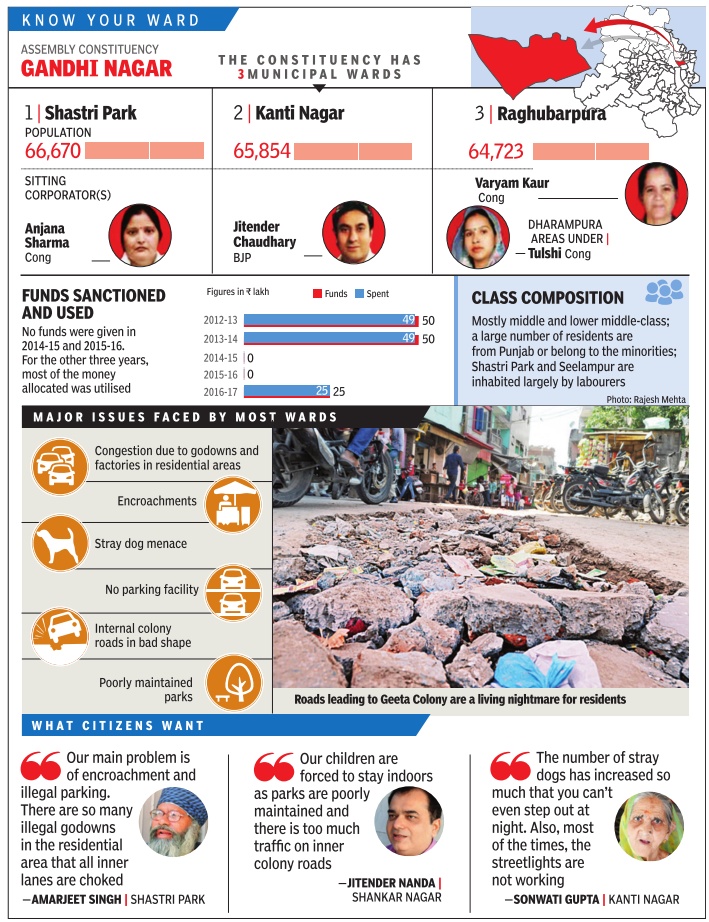Delhi: Gandhi Nagar
This is a collection of articles archived for the excellence of their content. |
Contents |
A constituency profile
2020
Vibha Sharma, January 24, 2020: The Times of India

From: Vibha Sharma, January 24, 2020: The Times of India
NEW DELHI: The voters of Gandhi Nagar assembly constituency in east Delhi have some complaints, but don’t have someone they can pin the blame on. For eight months, the constituency hasn’t had an MLA after Anil Kumar Bajpai, elected in 2015 as an Aam Aadmi Party nominee, joined BJP ahead of general elections last year and was disqualified under the anti-defection law.
The constituency is known for being home to the biggest readymade garments wholesale market and has an interesting mix of Muslim, Sikh and Hindu communities. For 17 years it remained a Congress domain until Bajpai wrested it in 2015. The constituents claimed that development projects in the area began after AAP assumed power, but all work was put on hold after the MLA joined BJP.
Last Tuesday, TOI saw road construction under way in various places, including Jheel Chowk and Azad Nagar. But also visible were massive encroachments on the roads, poor sanitation and unregulated traffic. Despite the Supreme Court’s explicit directions regarding the loading and unloading of merchandise during non-peak hours, there were goods vehicles and tempos parked outside Gandhi Nagar shops in the afternoon. To add to the chaos, shop owners had taken over large spaces on roads to display their wares.
People living in West Azad Nagar listed water supply and sewage among their woes. “Entire Azad Nagar gets poor-quality water and we are forced to use bottled water,” grumbled Pankaj Akhil.
“We are fed up of the encroachment on roads. It has multiplied in the past five years,” said Shankar Nagar resident Kamal Bhasin. He also said that in the run-up to assembly polls, road work had been taken up in his locality.
In the trader community, there is an undertone of surliness against the sealing of shops for violation of norms.
In Old and New Seelampur, dominated by the Muslim community, the ruling party gets a thumbs up.
Civic issues
2017
Paras Singh, Gandhi Nagar seethes at yrs of neglect , April 4, 2017: The Times of India

The title of being one of the “World's Most Notorious Markets“ is not something that Gandhi Nagar savours. Rampant violation of intellectual property rights made the US Trade Representative include the east Delhi trading centre in the list last year. Businessmen, however, love touting the place as Asia's largest wholesale market for readymade apparel. That is why clothes businessman Dalvinder Singh is miffed. “Being a market of this size, we contribute so much in taxes, but what do we get in return?“ he asked. He gave the answer himself: “Absolutely nothing in terms of civic facilities.“
Home to a teeming mass that trades in and manufactures affordable apparel, this bustling, four-decade-old community along the banks of the Yamuna Pushta Road is now crumbling. From heavily encroached footpaths, overflowing drains, narrow roads cramped by illegally constructed factories and godowns and the lack of public toilets, its largely middle and lowermiddle income population have a lot to contend with.
Political parties will fight to win the three East Delhi Municipal Corporation seats of Shastri Park, Kanti Nagar and Raghubarpura falling in the Gandhi Nagar assembly constituency , but victory will come with the onerous burden of having to meet the civic expectations of the thousands who run the 20,000 cottage-industry units in localities like Dharampura, Seelampur, Ajeet Nagar and Raghubarpura that produce apparel sold by the 10,000 shops of Gandhi Nagar.
“Even the entrance to the corporation's own office near the market remains blocked by illegally parked trucks,“ sneered Amarjeet Singh, 66, a Multani Mohalla resident who came to this area in 1970 when it consisted of vacant fields. Harjeet Singh of Radha Swami Satsang Beas Colony elaborated, “Illegal godowns and workshops operate in every locality and their transport vehicles jam the already constricted roads.“ The anger of the residents is palpable. The identification boards of local representatives have been blackened out and some bold wall graffiti demand to know from the area MP , MLA and corporator who is responsibi lity for the civic mess.
With the market affording a livelihood for everyone, almost all vacant plots have seen jhuggis coming up on them.Afar Khan, head of the vendors' association near Shastri Park metro station, alleged that residents are forced to pay bribes to corporation employ ees to be let alone. But this does not guarantee civic amenities.Md Harul of Buland Masjid in Shastri Park complained that corporation workers did not visit their locality . “Who wins from here or whether there are three or four wards is irrelevant to us,“ he said. “After all, we will have to continue spending our own money to have garbage removed from the roads once every week.“
It is not as if Gandhi Nagar hasn't had adequate representation in the corporation. Jitender Chaudhary , chairman of the standing committee, and Varyam Kaur, leader of the Opposition, are both from the area. “At least, Chaudhary is visible and visits us in times of happiness or sorrow,“ said Jitender Nanda, a trader who lives in Shankar Nagar. But he admitted all the same that the roads were broken, the street lights did not function and the parks have not been maintained in the municipal wards.